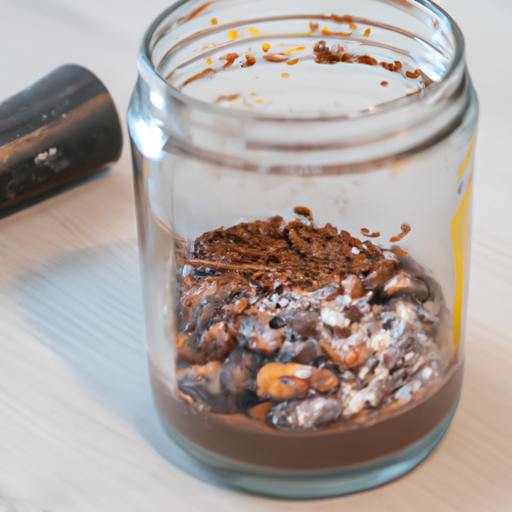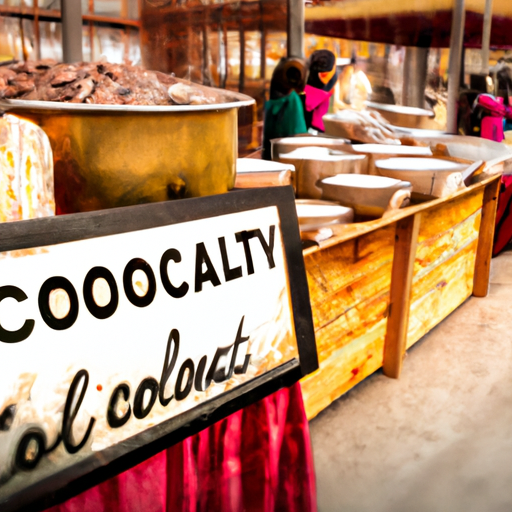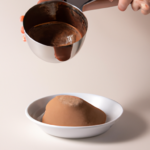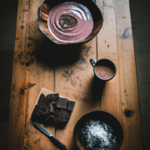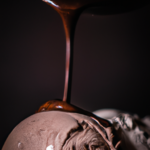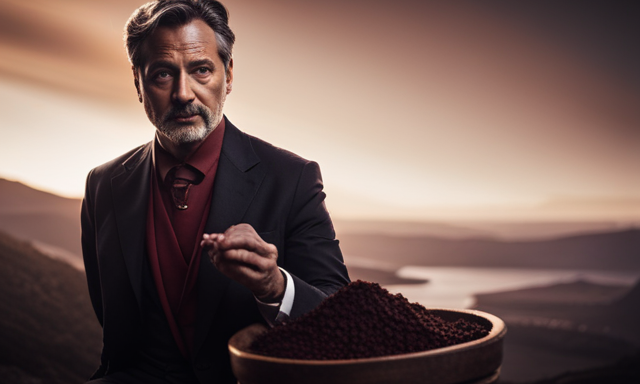Did you know that consuming raw cacao can provide you with an abundance of antioxidants and minerals? Well, I recently discovered a delicious way to incorporate this superfood into my daily routine – by making my own raw cacao spread! In this article, I will guide you through the simple steps to create this delectable treat right in your own kitchen.
First, gather your ingredients – coconut oil, raw cacao powder, and a sweetener of your choice.
Then, melt the coconut oil and mix in the raw cacao powder until smooth.
Sweeten to your desired taste and blend until the spread reaches a creamy consistency.
If needed, adjust the consistency by adding more coconut oil or cacao powder.
Once you’re satisfied, transfer the spread into a jar and let it set.
Now, you can enjoy this irresistible raw cacao spread on toast, fruit, or even straight from the spoon!
Get ready to indulge in a nutritious and decadent treat that will satisfy your chocolate cravings while nourishing your body.
Let’s get started!
Key Takeaways
- Raw cacao spread can be easily made at home using coconut oil, raw cacao powder, and a sweetener of choice.
- The consistency of the spread can be adjusted by adding almond milk or coconut water.
- Homemade raw cacao spread offers endless possibilities in recipes and can be used as a spread, dip, or drizzle.
- The customization and versatility of raw cacao spread allow for personal taste preferences and the use of alternative sweeteners.
Gather Your Ingredients
Now it’s time to gather all of your mouthwatering ingredients for making your delicious raw cacao spread!
Raw cacao is not only incredibly delicious, but it also comes with a wide range of health benefits. It’s packed with antioxidants, vitamins, and minerals that can boost your mood, improve cardiovascular health, and even enhance cognitive function.
As for the different ways to use raw cacao spread in recipes, the possibilities are endless. You can spread it on toast, swirl it into yogurt or oatmeal, drizzle it over fruits, or even use it as a dip for pretzels or crackers. The rich and creamy texture of the spread adds a decadent touch to any dish.
So let’s get started by melting the coconut oil.
Melt the Coconut Oil
First, you’ll need to heat up that coconut oil until it’s as smooth and silky as a tropical breeze. As you melt the coconut oil, it will transform from a solid into a golden liquid, releasing its delightful aroma. The warm oil will be the perfect base for mixing in the raw cacao powder, which is packed with antioxidants and can promote cardiovascular health.
Mix in the Raw Cacao Powder
After the coconut oil has been melted to a smooth consistency, it’s time to blend in the rich and antioxidant-packed raw cacao powder, creating a heavenly chocolate mixture.
Raw cacao powder is a versatile ingredient that can be used in a variety of ways. Not only does it add a deep, rich flavor to desserts and smoothies, but it also provides numerous health benefits. Incorporating raw cacao into your daily diet can boost your mood, improve cognitive function, and even support heart health.
To make the most of this superfood, try adding a spoonful of raw cacao powder to your morning oatmeal or yogurt. You can also use it as a substitute for cocoa powder in your favorite recipes.
Now that the raw cacao powder has been mixed in, it’s time to move on to the next step: sweetening to taste.
Sweeten to Taste
To add a touch of sweetness, you can customize the flavor of the chocolate spread by sweetening it to your taste. For example, you could try adding a drizzle of honey for a natural sweetness or a sprinkle of stevia for a sugar-free option.
These alternative sweeteners not only enhance the taste of the cacao spread but also offer various health benefits. Honey is known for its antibacterial properties and potential antioxidant effects, while stevia is a zero-calorie sweetener that can help regulate blood sugar levels.
Experimenting with these sweeteners allows you to tailor the spread to your preferences and dietary needs.
Now that you’ve sweetened the mixture, it’s time to blend until smooth, creating a luscious and creamy raw cacao spread.
Blend Until Smooth
Start by blending the mixture until it becomes smooth and velvety, creating a decadent and irresistible chocolatey delight. To achieve the perfect consistency, it’s important to use a high-speed blender. This will ensure that all the ingredients are thoroughly combined and the spread turns out creamy and luscious.
If you don’t have a high-speed blender, you can still make a delicious cacao spread, but it may take a bit longer to achieve the desired smoothness. Another tip is to periodically scrape down the sides of the blender to ensure everything gets blended evenly.
Once blended, you can use the spread on toast, fruits, or even as a filling for pastries.
Now that the mixture is smooth, let’s move on to the next step of adjusting the consistency if needed.
Adjust Consistency if Needed
If the mixture seems too thick, simply add a splash of your preferred liquid, like almond milk or coconut water, to achieve a smoother and more pourable consistency. Adjusting the consistency allows you to create the perfect texture for your raw cacao spread.
Additionally, you can get creative and experiment with adding different flavors to enhance the taste. Try incorporating ingredients like vanilla extract, cinnamon, or even a pinch of sea salt to elevate the flavor profile.
Furthermore, if you prefer a sweeter spread, you can explore using alternative sweeteners like maple syrup, honey, or coconut sugar instead of regular sugar. These options provide a natural and healthier alternative.
Once you have achieved the desired consistency and flavor, you can then proceed to transfer the delicious spread into a jar.
Transfer to a Jar
Once you’ve achieved the perfect consistency and flavor, it’s time to transfer your luscious creation into a jar, just like pouring golden honey into a glass jar, filling it to the brim with rich goodness. To ensure the longevity of your raw cacao spread, it’s important to consider storage options. A tightly sealed glass jar is ideal, as it prevents air and moisture from spoiling the spread. Additionally, storing it in a cool, dark place, like a pantry or cupboard, will help maintain its freshness and prevent any unwanted changes in texture or taste.
Now that your raw cacao spread is neatly stored in a jar, let’s explore some creative uses beyond spreading it on toast. This versatile delight can be drizzled over pancakes or waffles, mixed into smoothies or yogurt, or even used as a decadent dip for fresh fruit. The possibilities are endless, so unleash your culinary creativity and savor the chocolatey goodness in various ways.
As you let it set, the raw cacao spread will continue to develop its flavors and thicken slightly, making it even more delightful to enjoy.
Let it Set
After transferring the raw cacao spread to a jar, the next crucial step is to let it set.
This is where patience becomes essential. Allowing the spread to rest and solidify ensures a smooth and creamy consistency that is perfect for spreading on toast or dipping fruits.
During the setting process, the spread transforms into a delectable treat that is both rich and indulgent. As it cools, the flavors meld together, intensifying the chocolatey taste.
It’s fascinating to explore the different variations of raw cacao spread consistency that can be achieved by adjusting the setting time. Whether you prefer a soft and gooey texture or a firmer, spreadable one, the choice is yours.
So, while the raw cacao spread sets, take a moment to prepare for the ultimate enjoyment that awaits!
Enjoy!
Savor the incredible flavors of this delightful treat and indulge in a moment of pure bliss. Once you’ve let your homemade raw cacao spread set, it’s time to enjoy all the delicious possibilities it offers.
There are so many ways to use raw cacao spread in recipes, adding a rich and decadent touch to your favorite dishes. Spread it on toast or pancakes for a sweet breakfast treat, or swirl it into your morning oatmeal for an extra burst of chocolatey goodness. You can also use it as a dip for fresh fruit or drizzle it over yogurt for a healthy dessert option.
Not only does raw cacao spread taste amazing, but it also has numerous health benefits. Packed with antioxidants and minerals, it can boost your mood, improve heart health, and even enhance brain function.
So go ahead, indulge in this delectable treat and reap the rewards of its incredible flavors and health benefits.
Frequently Asked Questions
How long does it take for the raw cacao spread to set in the jar?
The raw cacao spread takes a few hours to set in the jar, like a dream solidifying into reality. To properly store it, keep it in a cool, dry place. You can use it in various recipes, like smoothies, desserts, or as a delicious spread on toast.
Can I use regular cocoa powder instead of raw cacao powder?
Yes, you can use regular cocoa powder instead of raw cacao powder. However, there will be some flavor differences, as raw cacao has a more intense and slightly bitter taste. Additionally, raw cacao has more nutritional benefits compared to regular cocoa.
Is it necessary to use coconut oil, or can I substitute it with another type of oil?
You can substitute coconut oil in raw cacao spread with other types of oil like almond oil or olive oil. Different oils offer various health benefits, such as almond oil promoting heart health and olive oil providing anti-inflammatory properties.
Can I add other ingredients like nuts or dried fruits to the raw cacao spread?
Adding nuts and dried fruits to homemade cacao spread is like adding fuel to the fire. It enhances the flavor and adds a delightful crunch. Get creative with almonds, walnuts, or even cranberries, and take your cacao spread to a whole new level!
How long can the raw cacao spread be stored before it goes bad?
The shelf life of raw cacao spread depends on storage conditions. When stored in an airtight container in a cool, dry place, it can last for up to three months. Proper storage helps maintain its freshness and prevent it from going bad.
Can I Use Raw Cacao Tincture in Place of Raw Cacao Spread in Recipes?
Yes, you can use raw cacao tincture in place of raw cacao spread in recipes. The tincture will provide the same rich chocolate flavor to your dishes. Just be mindful of the potency, as tinctures are more concentrated. Adjust the quantity accordingly in your raw cacao tincture recipe.
Conclusion
And there you have it, a delectable homemade raw cacao spread that will satisfy your chocolate cravings like no other.
As the smooth mixture of coconut oil and rich cacao powder coats your taste buds, you’ll be transported to a world of pure indulgence.
The sweetness, carefully adjusted to your liking, will dance on your palate, leaving you craving for more.
So go ahead, transfer this luscious spread into a jar, let it set, and get ready to experience a heavenly treat that will leave you wanting seconds.
Enjoy every spoonful!

